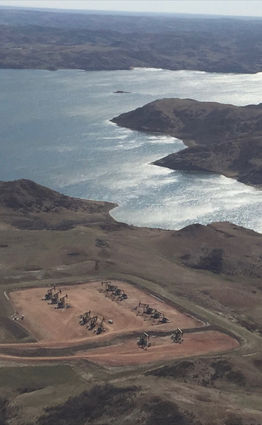Over Morning Coffee
Pipelines are a lifeline for many Western states
February 4, 2021
On Jan. 20, within hours of entering the Oval Office, President Biden signed an executive order halting further development of the Keystone XL pipeline. In doing so, he set in motion a series of events harmful to our economy and energy independence. He also jeopardized the future of many families and communities in our Western states.
The Keystone XL is only the latest in a long list of pipelines met with lawsuits and demonstrations by environmentalists. The Keystone Pipeline (predecessor of the Keystone XL) and Trans-Alaska Pipeline's proposed expansion into Arctic National Wildlife Refuge were both embroiled in controversy. More recently, protests erupted near the Standing Rock Indian Reservation in North Dakota in an effort to stop the Dakota Access Pipeline.
When my son-in-law worked in the North Dakota oil fields, I made many trips there to visit family. In my travels, I became friends with the locals and gained a deeper understanding of the difficulties of developing and maintaining the oil industry in North Dakota.
Oil wells had been in the state for decades, but the use of fracking in the Bakken started an oil boom around 2012. In a scene reminiscent of the California Gold Rush, people flocked to North Dakota to seek their fortune. With the rapid influx of new people came stress to infrastructure, schools, supply-lines and health care. A shortage of housing led to the growth of "man-camps" created out of tents and RVs.
Early on, the oil glut had a disastrous impact on the state's farmers and ranchers. Their income tanked because all available trucks and trailers were hauling salt water (used in fracking), crude oil and pipe. Ag producers had no way to get products to market. Main Street in the small town of Watford City became so congested with bumper-to-bumper, double-parked vehicles that it was impossible to walk across the street.
Eventually, as roads, housing and public entities adjusted to accommodate the increased population, those issues were resolved and overall, the state has thrived because of the oil boom. Twelve thousand jobs were created during construction. Mechanics, electricians, pipefitters and heavy equipment operators were needed. Local economies grew with the need for more lodging, food and other services.
Energy Transfer built the Dakota Access Pipeline (DAPL) to move increased volumes of oil out of North Dakota. It was completed from the Bakken in the northwest almost to the South Dakota border when trouble erupted near the Standing Rock Reservation in 2016. Work came to a halt when environmental activists blocked construction north of the reservation. Most of them were outsiders, many of them paid, who came from across the country to disrupt work on the pipeline. These protests continued for months, ending when winter came and protestors abandoned their campsites.
Eventually, DAPL was completed. It bypassed the reservation and met all environmental requirements. The 30" underground pipeline spans 1,170 miles from North Dakota to Illinois and has been operational without any failures or environmental problems for three years. It moves 570,000 barrels of crude through the state daily. This is down from 1.3 million barrels before COVID-19.
The state receives a rebate on every barrel of oil and this money is passed on to North Dakotans in the form of lower property taxes and fuel prices, as well as increased funding for schools, hospitals and emergency services. Energy Transfer donates millions of dollars to community needs annually.
Even though DAPL met all the ecological requirements and has all the necessary permits, the environmental lobby continually works to shut it down. In July of 2020, a district court judge in Washington, D.C., ruled the pipeline be shut down and its volume emptied pending further environmental studies. In August, an appeals court sided with Energy Transfer and issued a stay to keep the oil flowing. Expected changes in regulatory requirements coming from the new administration in Washington may shut the pipeline down, again.
The story of the Dakota Access Pipeline in North Dakota is not unique. Similar scenarios play out wherever the oil industry is developed. Building a pipeline is an arduous and expensive process. Getting the necessary permits from numerous states and the federal government takes years. In-depth environmental studies take time. Purchasing land from private landowners is expensive. Construction is extremely expensive and requires highly-skilled labor. The decision to build a pipeline is a serious commitment, but they are proven to be the safest, fastest and cheapest way to transport crude.
Oil pipelines are a complex issue that must be addressed from many angles. Decisions should not be dominated by one political party or interest group. Too much is a stake. For the state governments that rely on oil revenue for their budgets and the thousands of families that depend on pipeline jobs for their livelihood, the pipeline is a lifeline. The president should not be able to stop the flow of oil with a stroke of his pen.
Bonnie Ewoldt, of rural Milford, is a retired teacher, news junkie and freelance writer. Her opinion pieces have appeared online and in newspapers across Iowa and neighboring states. Visit her blog at http://www.bonniesblogbox.wordpress.com.






